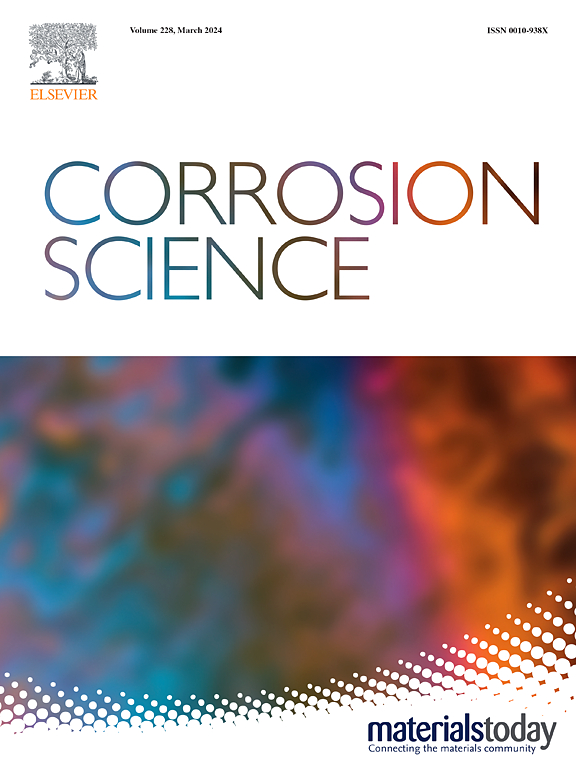Corrosion fatigue crack propagation behaviour in different micro-regions of steel/aluminum laser-MIG hybrid fusion-brazed joints
IF 7.4
1区 材料科学
Q1 MATERIALS SCIENCE, MULTIDISCIPLINARY
引用次数: 0
Abstract
Evaluating corrosion fatigue crack propagation (CFCP) behaviour in different micro-regions of steel/aluminium welded joints is crucial for ensuring the safety and reliability of these joints in service environments. However, the CFCP behaviour of steel/aluminum welded joints has rarely been studied. This study explores the CFCP behaviour of steel/aluminium laser-metal inert gas hybrid fusion-brazed joints in different micro-regions under a simulated corrosive environment (3.5 wt% NaCl solution) at room temperature. A self-made 5 KN electronic servo testing machine was used to apply a sinusoidal wave load (stress ratio R = 0.1, frequency = 0.5 Hz) to single-edge notched tensile specimens. The notches were located at the weld, heat-affected zone (HAZ) and steel/aluminium interface (abbreviated as interface). The fatigue crack propagation rate (da/dN) of different micro-regions in steel/aluminium welded joints followed the order of interface > weld > HAZ under corrosive environment and air conditions. Compared with air, the corrosive environment triggered a markedly higher da/dN, irrespective of notch location at the weld, HAZ or interface. This accelerated da/dN resulted from the combined effects of anodic dissolution, chloride ions and galvanic corrosion. The electron backscatter diffraction results indicated that compared with the weld and HAZ specimens, the HAZ specimen exhibited lower da/dN, attributed to its small grains, higher proportion of high-angle grain boundaries and increased geometrically necessary dislocation density. Fatigue striations were clearly observed on the weld and HAZ fracture surfaces, while a brittle fracture pattern was observed on the corrosion fatigue fracture surface for the interface.
钢/铝激光-MIG 混合熔融钎焊接头不同微区的腐蚀疲劳裂纹扩展行为
评估钢/铝焊接接头不同微区的腐蚀疲劳裂纹扩展(CFCP)行为对于确保这些接头在使用环境中的安全性和可靠性至关重要。然而,有关钢/铝焊接接头 CFCP 行为的研究却很少。本研究探讨了室温下模拟腐蚀环境(3.5 wt% NaCl 溶液)中钢/铝激光-金属惰性气体混合熔融钎焊接头在不同微区的 CFCP 行为。使用自制的 5 KN 电子伺服试验机对单边缺口拉伸试样施加正弦波载荷(应力比 R = 0.1,频率 = 0.5 Hz)。缺口位于焊缝、热影响区(HAZ)和钢/铝界面(简称界面)。在腐蚀环境和空气条件下,钢/铝焊接接头不同微区的疲劳裂纹扩展率(da/dN)依次为界面、焊缝、热影响区。与空气条件相比,腐蚀环境导致的 da/dN 明显更高,无论缺口位置在焊缝、HAZ 还是界面上。这种加速的 da/dN 是阳极溶解、氯离子和电化学腐蚀共同作用的结果。电子反向散射衍射结果表明,与焊缝和 HAZ 试样相比,HAZ 试样的 da/dN 值较低,这归因于其晶粒较小、高角度晶界比例较高以及几何必要位错密度增加。在焊缝和 HAZ 断口表面可清晰观察到疲劳条纹,而在界面的腐蚀疲劳断口表面则可观察到脆性断裂模式。
本文章由计算机程序翻译,如有差异,请以英文原文为准。
求助全文
约1分钟内获得全文
求助全文
来源期刊

Corrosion Science
工程技术-材料科学:综合
CiteScore
13.60
自引率
18.10%
发文量
763
审稿时长
46 days
期刊介绍:
Corrosion occurrence and its practical control encompass a vast array of scientific knowledge. Corrosion Science endeavors to serve as the conduit for the exchange of ideas, developments, and research across all facets of this field, encompassing both metallic and non-metallic corrosion. The scope of this international journal is broad and inclusive. Published papers span from highly theoretical inquiries to essentially practical applications, covering diverse areas such as high-temperature oxidation, passivity, anodic oxidation, biochemical corrosion, stress corrosion cracking, and corrosion control mechanisms and methodologies.
This journal publishes original papers and critical reviews across the spectrum of pure and applied corrosion, material degradation, and surface science and engineering. It serves as a crucial link connecting metallurgists, materials scientists, and researchers investigating corrosion and degradation phenomena. Join us in advancing knowledge and understanding in the vital field of corrosion science.
 求助内容:
求助内容: 应助结果提醒方式:
应助结果提醒方式:


